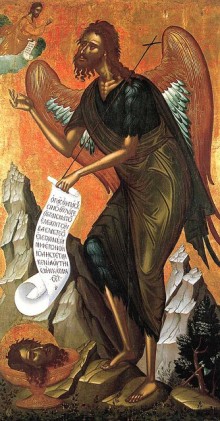Yet icons tell us the stories of the saints they depict. For example, if a saint is holding a cross, that means the saint was a martyr. Saints who are holding scrolls are considered saints of holy wisdom who contributed to our theology and beliefs. Female saints wearing white veils were virgins, while females in colorful veils were not. One of the key parts of St. John the Forerunner’s story is that he was martyred in an unconventional and brutal way: He had his head cut off at the request of Herod’s niece. So most icons of St. John have him holding a cross in one hand to signify that he is a martyr, and holding his own head on a platter or in a chalice in the other hand to remind us of the evil way he was martyred and the sacrifice he made for his cousin, and our Savior, Jesus.
Sometimes you will find an icon of St. John that shows a baby instead of his head on the platter. That baby is Jesus, and it represents the Lamb of God. The image of Jesus reminds us that St. John’s purpose was the prepare the way for Jesus. It also is a reminder that John leapt in Elizabeth’s womb when Mary came to meet her and tell her she was pregnant with Jesus. Even before he was born, John sensed his purpose and knew how special Jesus was.
St. John the Forerunner is almost always dressed in a green robe. This is often a symbol of nature or earthliness, and is seen on ascetic saints who spent much of their life in the wilderness. In his icon, his hair is often long and disheveled, and the tunic under his green robe looks wavy like animal hair. All of this is to depict his life in the desert, foregoing the typical comforts of life for bugs and camel hair.
Another interesting thing in this icon is that St. John has wings. That bothered me at first. I felt that it was inappropriate to equate a human to an angel. Angels, obviously are higher and holier than human beings! However, Orthodoxy does not necessarily subscribe to that opinion. Mary is believed to be “more honorable than the cherubim and more glorious beyond compare than the Seraphim,” because she was part of the Incarnation, while the angels weren’t. St. John is depicted with wings because he was a messenger of God. The word angel means “messenger,” and each time angels are mentioned in the Bible, they are used to bring humans a message from God. Since St. John was a messenger or prophet sent to prepare people for Jesus’ arrival, he is considered angel-like because he brought an important message from God to earth. In addition, many ascetic saints are called angels because of their commitment to holy lives that avoid many worldly “pleasures” such as marriage, family life, shelter, abundant food, and comfort in general. St. John the Forerunner is often called “Angel of the Desert”.
| Icon by Fikos (from here) |
That experience got me thinking about what a modern St. John would be like. Living on the streets. Sleeping in the shelter of a cardboard box. Hair matted and dirty. Ripped jeans, long-sleeved faded green thermal shirt. I can see him standing on the street corner in a big city, calling out the money-launderers and big monopolies. Or maybe he lives in the woods, foraging along with the animals and sleeping in the leaves.
Maybe he waits next to a cold running creek for hikers and nature lovers. Maybe they see his bearded face and talk with him for a few minutes. Maybe they let him pour the stinging water over their hands. Maybe they see his thinness and give him a couple of granola bars. I don’t know. I suppose a 21st century St. John could just as easily be a controversial blogger calling people to repent.
Sometimes I find myself searching for a prophet, someone to show me the way. I feel like we’ve lost faith in signs and signals, visions and dreams. We’re left with very little to guide us, other than what our culture offers: social media, product marketing, and celebrity.
Sometimes, I want to be the one who shrinks away to the wilderness, away from the noise and the technology, where the path to God might be easier to find.
Image used by permission from Jim Forest.
Karissa Knox Sorrell is a writer, poet, and educator. She has been Orthodox for almost ten years and her patron saint is St. Nonna, the mother of Gregory of Nazianzus. Read more of Karissa’s work at her blog, or find her on Twitter.
Click:
St Artemios the Great Martyr of Antioch & St Matrona of Chios
God's little sparrow
The Icon of Resurrection or The descent into Hades
God the Holy Trinity: 'The Lover of Mankind'
People as Liturgical Beings
A Different Light: Youthful Travelers in Contemporary America
Travelers on the Way to the Light
Klaus Kenneth, the spiritual traveler
Two Orthodox Missions in USA
Why I'm not an atheist
Miley Cyrus, or: why Orthodox Mission in the West is an urgent need...
Arriving at the Last True Rebellion
The holy anarchists
Arriving at the Last True Rebellion

Δεν υπάρχουν σχόλια:
Δημοσίευση σχολίου